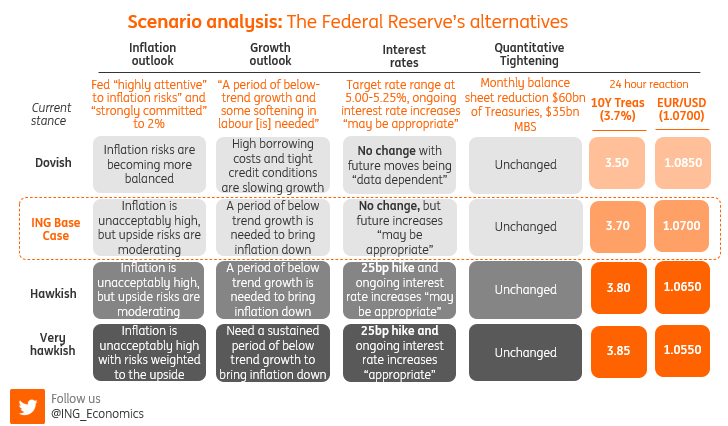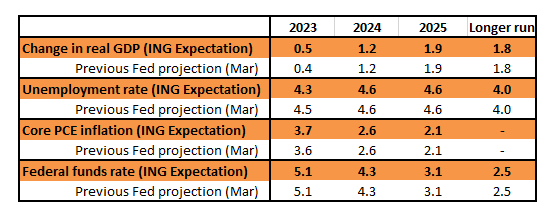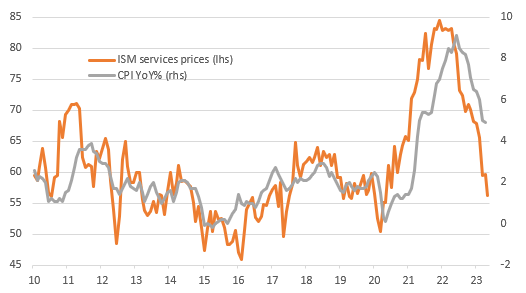Fed Likely To Skip, But It’s Going To Be Close
Market pricing has shifted massively over recent weeks, but we think the most likely outcome remains the Fed leaving policy rates unchanged on 14 June. There will be some dissent and a shock inflation reading could make it a very close decision. Either way, the Fed will leave the door open to further rate moves.
(Click on image to enlarge)

ING
No change the most likely outcome
Just over a month ago, Federal Reserve Chair Jerome Powell hinted that after 500bp of rate hikes over a 14 month period, interest rates may finally have entered restrictive territory and the Fed could pause at the June meeting to take some time to evaluate the effects. Markets took this as a signal that we may already be at the peak with the fear that the combination of high borrowing costs and tighter lending conditions could prompt a recession with inflation falling swiftly back towards target. On 4 May, Fed funds futures contracts were pricing in 86bp of interest rate cuts by year end and the target range heading below 4% at the January 2024 FOMC meeting.
Over the subsequent six weeks, activity has remained resilient, inflation continues to run hot, payrolls jumped 339,000 and the Australian and Canadian central banks surprisingly hiked rates. Hawkish comments from a few Fed officials have added to the sense that they may not be done. The result is that pricing for the June FOMC meeting is not far off a coin toss (just under 10bp priced) and July is looking a decent bet for a hike (21bp priced). Next Tuesday’s CPI report could see pricing move even further in favour of a hike – currently the consensus is for core CPI to come in at 0.4% month-on-month, but if we get a shock 0.5% that could be sufficient to convince enough FOMC members to vote for a hike.
That’s not our base case and we believe there will be a majority on the committee who think they have tightened policy a lot and it makes sense to wait. This was certainly the commentary from senior Fed officials such as Governor Philip Jefferson and Philadelphia Fed Governor Patrick Harker, that while “there is still significant room for improvement” the Fed is “close to the point where we can hold rates in place and let monetary policy do its work”. Moreover, recent data releases have been sending very mixed messages, which suggests it may make sense pause to evaluate.
Conflicting data makes life hard for the Fed
Friday’s Labour report is a notable example. The establishment survey, which questions employers and generates the non-farm payrolls number, reported a jump of 339,000 in employment in May. However, the household survey, used to calculate the unemployment rate, showed employment declined 310,000 with unemployment rising 440,000. Then we have the manufacturing ISM reporting a rise in its employment survey yet the payrolls report stated there was a 2000 decline. Meanwhile, service sector payrolls rose 257,000 yet the ISM services employment index fell into contraction territory.
We see similar mixed messages within the GDP report. On an expenditure basis, GDP grew 1.3% annualised in 1Q 2023 and 2.6% in 4Q 2022. However, an alternative measure of US economic activity, Gross Domestic Income, which combines all the costs incurred and incomes earned in the production of GDP, contracted 2.3% annualised in 1Q 2023 after a 3.3% drop in 4Q 2022 and has declined in three out of the past four quarters. An average of the two series suggests the economy has flatlined since 3Q 2022.
Fed to leave the door open for further hikes
Nonetheless, the Fed wants to see 0.2% month-on-month or below CPI readings to be confident inflation will return to 2%. We aren’t there yet so if they do hold rates steady, as we predict, it is likely to be a hawkish hold with the door left open to further rate hikes if inflation doesn’t slow – July is clearly a risk. We certainly acknowledge the risk that they hike rates 25bp, especially if Tuesday’s inflation data surprises to the upside, but doubt they will intensify the language on rate hikes so the “hawkish hike” scenario in the table above looks unlikely.
ING's expectations for what the Federal Reserve will forecast next week

Macrobond, ING
We will also get the Fed’s updated forecasts and dot plot chart for individual forecasts for the path of the Fed funds rate. In March, they signalled rates would be left in a 5-5.25% range through to year-end with rate cuts in 2024. We suspect there will be only minor tweaks in their forecasts – our predictions for what they will say are in the table above. Nonetheless, the big risk is that even if they do hold rates steady next week they insert a further hike into their central forecast, which will see markets firmly swing in favour of a 25bp move in July.
We still look for large rate cuts, but we may be too early on the timing
The accompanying press conference will continue to emphasise they do not expect to cut rates this year and the risks for interest rates remains firmly to the upside. Our own view has long been for rate cuts this year due to a combination of aggressive rate hikes, tighter lending conditions, a stagnant housing market and business surveys being consistent with recession. We are also of the view that inflation will fall sharply through the second half of 2023 with the latest ISM services price index backing up other surveys pointing to strong disinflationary pressures emerging in the economy. We acknowledge our 100bp of rate cuts call for the fourth quarter is aggressive. There could be a bit of slippage into the first quarter of 2024, but we continue to believe the Fed funds rate will be around the 3% mark in mid-2024.
ISM services points to sharp inflation slowdown

Macrobond, ING
Tighter money market conditions post the debt ceiling suspension are doing some of the job for the Fed
From a system perspective, the debt ceiling resolution leaves the Fed with one less thing to worry about. An important one – the viability of the system. But there are repercussions that need monitoring, specifically to do with liquidity management.
Bills and other bond issues that had been held back are now being accelerated forward as the US Treasury looks to re-build its cash balance held at the Fed. To the extent that money market funds buy extra bills, it likely means less use of the Fed’s reverse repo facility. At the same time, as the Treasury’s cash balance is increased there should be an associated fall in bank reserves held at the Fed. This will make things feel that bit tighter.
Moreover, the combination of extra floating collateral and less liquidity should place some upward pressure on repo rates, adding to the tightening being felt generally. This will push in the same direction as tight Fed policy, in a way taking some pressure off the Fed to engineer an explicit hike, as the market is tightening things up on its own. Also, there is an underlying tightening coming from the rises in market rates seen in the past few weeks. This is largely a part reversal of the falls in market rates seen in the wake of the Silicon Valley Bank collapse. But still, it is helping the Fed do the tightening job that it believes needs doing.
Pitted against that, however, has been a tendency for credit spreads to tighten, volatility to fall and Libor OIS to re-tighten. These act to loosen conditions, but are also a consequence of the reduction in system stress as the debt ceiling was suspended and banking fears have receded, both of which the Fed welcomes.
Directionally, a decision to hold rates steady at this meeting should not have a material effect on the level of market rates. What’s more important is the tone and language used by Chair Powell, where a hawkish tilt should prevent yields from choosing to use this event as a rationale to move lower. In contrast, a surprise hike would deepen the inversion and shift the curve materially higher (by some 10bp in the 10yr and 20bp in the 2yr).
Late cycle dollar strength looks set to continue
The dollar has reclaimed a lot of the weakness suffered on the back of the US regional banking crisis in March. And trade-weighted measures of the dollar are about flat on a year-to-date basis. Looking at the immediate event risk of the forthcoming FOMC meeting, it is hard to get too bearish on the dollar. It is not as though there is an awful lot of further tightening priced into dollar money market curves – which could be priced out were Chair Powell to focus on the need for a pause.
As recent events in Canada and Australia remind us, central banks remain frustrated that core inflation is not falling more quickly and, if anything, look prepared to engineer even weaker growth to secure their inflation credibility. That means inverted yield curves and late cycle dollar strength may stay with us longer than we initially thought.
In practice then, this means that EUR/USD could hover near 1.06/1.07 for another one to two months – or until there is some very clear evidence of US disinflation or activity data weak enough to influence the Fed. In the bigger picture, however, the big drop in energy prices has markedly improved the fundamentals of EUR/USD. Our baseline assumes that something like 1.05 will be the worst case for EUR/USD this summer and we still like it ending the year above 1.15.
Another major driver in these low volatility FX markets remains the carry trade. The Japanese yen remains the preferred funding currency. A hawkish FOMC meeting, without too many fireworks, can see USD/JPY stay bid. However, Japanese authorities are already starting to express their displeasure again over the weak yen.
Two days after the FOMC, the Bank of Japan (BoJ) meets to set rates. We think the market is under pricing the chances of another adjustment in the Yield Curve Control regime, where the BoJ could shift to targeting yields shorter down the curve. This would be USD/JPY negative. However, unchanged policy from the BoJ and the market sinking its teeth into carry trade strategies warns that USD/JPY could grind towards the 145 area – where Tokyo intervened to buy yen last September.
More By This Author:
FX Daily: Data sensitivity at its highestCondensing Complex Macro Readings Into One Number For Rates
U.S. Household Wealth Rose $3tn In The First Quarter
Disclaimer: This publication has been prepared by the Economic and Financial Analysis Division of ING Bank N.V. (“ING”) solely for information purposes without regard to any ...
more


